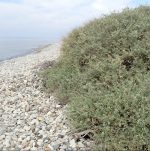
Also known as sea orache, this halophitic evergreen shrub is native to coastal areas of the Mediterranean Basin, North and East African and the Arabian Peninsula, and is a member of the Amaranthaceae that also includes spinach, beet, and celosia. It has a deep root, is highly branched, and grows 6-10′ tall. The silvery white leaves are ovate and up to 1.5″ long. Dense terminal panciles of small yellowish to green male and female flowers appear on leafless twigs on the same plant in mid summer. The kidney shaped fruits contain brown seeds. Mediterranean saltwort tolerates drought salt, wind, and alkaline soil so is a good choice for a seaside garden. It is also very tolerant of prunning and is commonly grown as an ornamental hedge in mild dry climates but can become invasive. The genus name, Atriplex, is the Greek name for orach, a related plant that can be used as spinach. The specific epithet, halimus, is from the Greek word Ἁλιμοῦς the name of a region of ancient Athens known for its sea weed, and refers to the fact that the plant can grow in saline soil..
Type: Evergreen shrub
Outstanding Feature: Tolerance to drought, wind, salt and heat
Form: Rounded
Growth Rate: Moderate
Bloom: Dense terminal panciles of small yellowish to green male and female flowers on leafless twigs on the same plant in mid summer.
Size: 6-10′ H x 9′ W
Light:Full sun
Soil: Average to lean, dry to medium moist, well-drained soil
Hardiness: Zones 7-11
Care: Prune to shape if desired.
Pests and Diseases: None of significance
Propagation: Seed, cuttings
Photo Credit:Wikimedia Commons